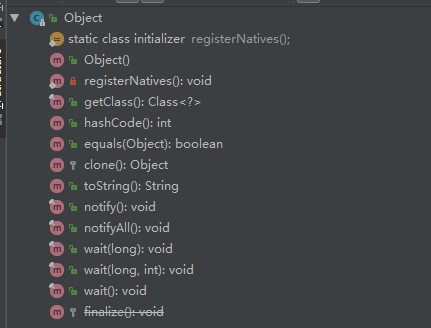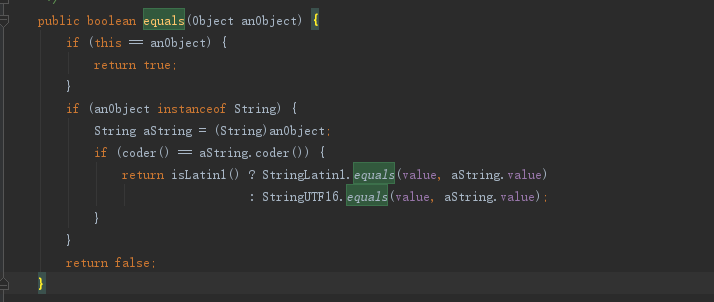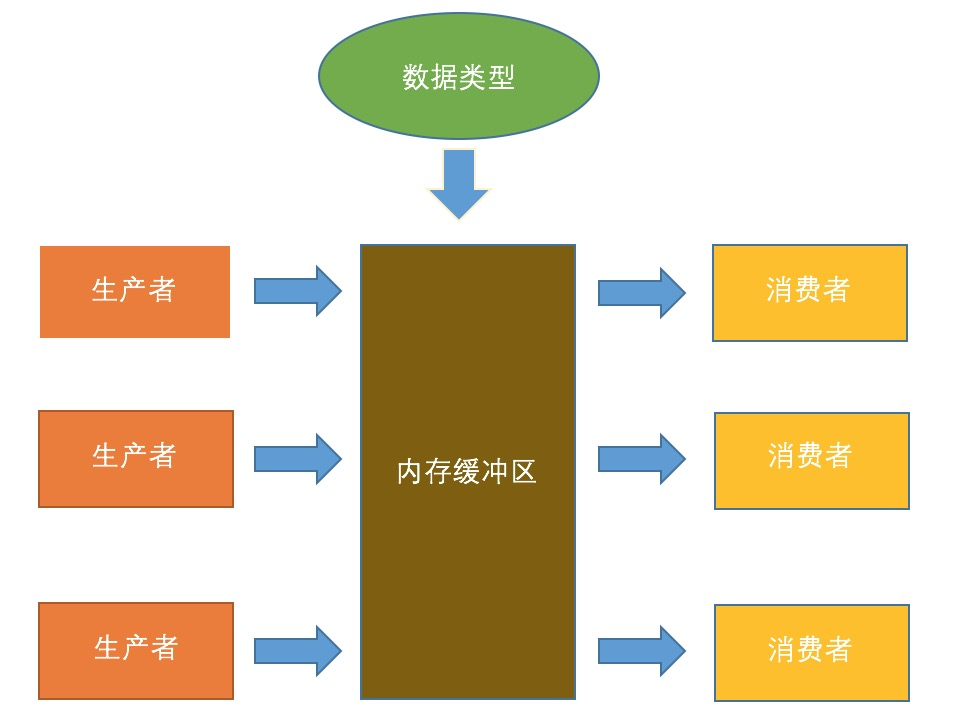Object中的wait、notify、notifyAll,以及基于此方法实现生产者消费者模式
一:Object是所有类的父类,即我们写的所有类都默认继承了此类,所有对象包括数组都实现了该类的方法;那么此类的方法是都应该有所了解的
下图给出JDK10中Object类的方法:

1.hashCode()方法
对象之间常用到equals方法,当对比两个对象的时候,通过hash生成一个对象的hash码,如果hash码相同,那么两个对象可能相同,如果hash码不同,那么两个对象肯定不同,可以增加对象对比的效率,一般对象在重写了equals方法都需要覆写此方法;这个方法在一些具有哈希功能的Collection中用到;
2.equals()方法
该方法是非常重要的一个方法。一般equals和==是不一样的,但是在Object中两者是一样的。子类一般都要重写这个方法。此处给出String的重写equals方法的例子

3. clone()方法
实现对象的浅复制,只有实现了Cloneable接口才可以调用该方法,否则抛出CloneNotSupportedException异常。此处没有什么好说的,直接上代码:
@Slf4j
public class TestObjectClone implements Cloneable {
private String name;
private int age;
public String getName() {
return name;
}
public void setName(String name) {
this.name = name;
}
public int getAge() {
return age;
}
public void setAge(int age) {
this.age = age;
}
@Override
protected TestObjectClone clone() throws CloneNotSupportedException {
return (TestObjectClone) super.clone();
}
public static void main(String[] args) {
TestObjectClone testObjectClone = new TestObjectClone();
testObjectClone.setName("java");
testObjectClone.setAge(23);
TestObjectClone testObjectClone2;
try {
testObjectClone2 = testObjectClone.clone();
log.info("名称是{},年龄是{}", testObjectClone2.getName(), testObjectClone2.getAge());
} catch (CloneNotSupportedException e) {
e.printStackTrace();
}
}
}
4. toString()方法
此方法常用方法;
5.notify()方法
法唤醒在该对象上等待的某个线程
6.wait()方法
使当前线程等待该对象的锁,当时当前线程必须持有该对象的锁,同时在执行wait方法是当前线程会自动释放掉该对象锁,单该线程会一直阻塞在wait方法,知道一下事件被唤醒:
(1)其他线程调用了该对象的notify方法。
(2)其他线程调用了该对象的notifyAll方法。
(3)其他线程调用了interrupt中断该线程。
(4)时间间隔到了。
7.notifyAll() 唤醒该对象的所有线程;
8.wait(long timeOut) 该线程睡眠,多久后自动唤醒
二:基于wait()和notifyAll()实现生产者消费者模式
生产者:
@Slf4j
public class Consumers implements Runnable {
private BlockingQueue<String> queue;
/**
* 工作效率
*/
private long millis;
public Consumers(BlockingQueue<String> queue, long millis) {
this.queue = queue;
this.millis = millis;
}
@Override
public void run() {
while (true) {
try {
Thread.sleep(millis);
String str = queue.take();
if (StringUtils.isNullOrEmpty(str)) {
synchronized (queue) {
queue.wait();
}
} else {
synchronized (queue) {
queue.remove(0);
queue.notifyAll();
log.info("消费者消费消息:{}", str);
}
}
} catch (InterruptedException e) {
e.printStackTrace();
}
}
}
}
消费者
@Slf4j
public class Producers implements Runnable {
private BlockingQueue<String> queue;
private long millis;
private static AtomicInteger atomicInteger = new AtomicInteger(0);
public Producers(BlockingQueue<String> queue, long millis) {
this.queue = queue;
this.millis = millis;
}
@Override
public void run() {
while (true) {
try {
Thread.sleep(millis);
synchronized (queue) {
if (queue.size() >= 100) {
queue.wait();
}
int news = atomicInteger.incrementAndGet();
if (queue.offer("生产者生产消息" + news)) {
log.info("新增消息:{}", news);
queue.notifyAll();
}
}
} catch (InterruptedException e) {
e.printStackTrace();
}
}
}
}
入口方法:
public class Main {
private static final ExecutorService executorService = ThreadPoolInstance.getThreadPollInstance(5, 200, 0L);
public static void main(String[] args) {
BlockingQueue<String> queue = new LinkedBlockingDeque<>(100);
Producers producers = new Producers(queue, 10);
Consumers consumers = new Consumers(queue, 20);
executorService.execute(producers);
executorService.execute(consumers);
}
}
运行结果:
11:10:18.137 [zl_pool-0] INFO com.zl.concurrency.example.object.waitnotify.Producers - 新增消息:1 11:10:18.152 [zl_pool-1] INFO com.zl.concurrency.example.object.waitnotify.Consumers - 消费者消费消息:生产者生产消息1 11:10:18.153 [zl_pool-0] INFO com.zl.concurrency.example.object.waitnotify.Producers - 新增消息:2 11:10:18.164 [zl_pool-0] INFO com.zl.concurrency.example.object.waitnotify.Producers - 新增消息:3 11:10:18.173 [zl_pool-1] INFO com.zl.concurrency.example.object.waitnotify.Consumers - 消费者消费消息:生产者生产消息2 11:10:18.175 [zl_pool-0] INFO com.zl.concurrency.example.object.waitnotify.Producers - 新增消息:4 11:10:18.186 [zl_pool-0] INFO com.zl.concurrency.example.object.waitnotify.Producers - 新增消息:5 11:10:18.194 [zl_pool-1] INFO com.zl.concurrency.example.object.waitnotify.Consumers - 消费者消费消息:生产者生产消息3 11:10:18.197 [zl_pool-0] INFO com.zl.concurrency.example.object.waitnotify.Producers - 新增消息:6 11:10:18.208 [zl_pool-0] INFO com.zl.concurrency.example.object.waitnotify.Producers - 新增消息:7 11:10:18.215 [zl_pool-1] INFO com.zl.concurrency.example.object.waitnotify.Consumers - 消费者消费消息:生产者生产消息4 ......................................... 11:10:24.680 [zl_pool-0] INFO com.zl.concurrency.example.object.waitnotify.Producers - 新增消息:412 11:10:24.701 [zl_pool-1] INFO com.zl.concurrency.example.object.waitnotify.Consumers - 消费者消费消息:生产者生产消息313 11:10:24.701 [zl_pool-0] INFO com.zl.concurrency.example.object.waitnotify.Producers - 新增消息:413 11:10:24.722 [zl_pool-1] INFO com.zl.concurrency.example.object.waitnotify.Consumers - 消费者消费消息:生产者生产消息314 11:10:24.722 [zl_pool-0] INFO com.zl.concurrency.example.object.waitnotify.Producers - 新增消息:414 11:10:24.743 [zl_pool-1] INFO com.zl.concurrency.example.object.waitnotify.Consumers - 消费者消费消息:生产者生产消息315 11:10:24.743 [zl_pool-0] INFO com.zl.concurrency.example.object.waitnotify.Producers - 新增消息:415 11:10:24.764 [zl_pool-1] INFO com.zl.concurrency.example.object.waitnotify.Consumers - 消费者消费消息:生产者生产消息316 11:10:24.764 [zl_pool-0] INFO com.zl.concurrency.example.object.waitnotify.Producers - 新增消息:416
结果分析:此处设置的生产者是10毫秒生产一个消息,消费者是20毫秒消费一个消息,队列长度是100,当队列满的时候停止生产,当队列为空的时候停止消费;所以开始时候,生产者效率大于消费者效率,当队列满了之后,会达到一个平衡;
具体模型如下:
我们曾如此渴望生命的波澜,到后来才发现,人生最曼妙的风景是内心的淡定与从容




 浙公网安备 33010602011771号
浙公网安备 33010602011771号